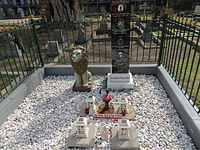Robert William Wilcox
Robert William Kalanihiapo Wilcox (February 15, 1855 – October 23, 1903),[2] nicknamed the Iron Duke of Hawaiʻi, was a Hawaiian revolutionary soldier and politician, who led uprisings against both the government of the Hawaiian Kingdom under King Kalākaua and the Republic of Hawaii under Sanford Dole, what are now known as the Wilcox rebellions.
[6] Wilcox's grandmother, Haupa, was descended from Umi-a-Liloa of Maui (not to be confused with the king of Hawaii Island) and Lonomakaihonua.
[7] In 1881, King David Kalākaua selected Wilcox and two other part-Hawaiian young men to study at the Royal Military Academy at Turin in the Kingdom of Italy as a part of the Education of Hawaiian Youths Abroad program.
Impressed with his military skills, Italian officials sent Wilcox to the Royal Application School for Engineer and Artillery Officers.
Through what was called the Bayonet Constitution, they removed most political authority from the monarch, and placed income and property requirements on voters limiting the electorate to only wealthy native Hawaiians, Americans, and Europeans.
Returning to Hawaiʻi in October with his wife Gina Sobrero, a baroness closely related to Italy's Colonna family, he began a short-lived career as a surveyor.
Wilcox along with Charles Wilson and Sam Nowlein, planned a coup d'état to replace Kalākaua with his sister Liliʻuokalani, but the plot was never executed.
Instead of returning to Italy, Wilcox took up residence in San Francisco, California, and worked as a surveyor while his wife Gina earned extra money teaching French and Italian.
Wilcox planned and this time executed another attempt to force King Kalākaua to sign a new constitution to replace the 1887 Document on July 30, 1889.
However, the conservatives in the original Reform Party, backed by the economic resources of the "Big Five" industrial corporations remained in power.
The paper attacked the extravagant lifestyle enjoyed by the Royal Family while the common people were suffering the effects of an economic slowdown.
[11] On November 1, 1892, Queen Liliʻuokalani appointed a new cabinet, and two hours later the Legislature (including Wilcox) voted to remove them from office.
Wilcox no longer directly attacked the Queen, but advocated modernization, and was quoted in the "San Francisco Examiner" that "...we should take some steps to secure commercial and political protection from some foreign country."
On January 14 Liliʻuokalani suspended the Legislature and told the cabinet to sign a new proposed constitution that would restore political power back to her.
During this time Wilcox, who was then a politician, was requested by Liliʻuokalani for his previous training in artillery to be put in command of the field pieces of the Royal Guard as they prepared themselves to defend the Queen.
The English language editor Clarence Ashford supported the Provisional Government of Hawaii, and expressed the view that the Queen had brought about her own downfall.
The key conspirators were Sam Nowlein, head of the Queen's guard, Charles T. Gulick, advisor to both Kalākaua and Liliʻuokalani, and William H. Rickard, a sugar planter of British parentage.
On January 1, 1898, he was pardoned by Sanford B. Dole, President of the Republic, who had previously pressured Liliʻuokalani to abdicate in exchange for his life and freedom, as well as for the lives of the others who had been sentenced to death.
On July 4, 1898, by passing the Newlands Resolution, the United States officially annexed Hawaii, and Republic President Dole appointed provisional Governor.
He hoped that his seat in the national capital in Washington, D.C. could be used to advocate for native Hawaiians, a community that he feared would be neglected by the American government.
Asked to contribute a short autobiography for the Congressional Directory, instead of the usual bland list of credentials, he described himself as "an indefatigable and fearless leader for his countrymen."
On August 20, 1896, Wilcox married Theresa Owana Kaʻohelelani Laʻanui (1860–1944), who was descended from a brother of King Kamehameha I.
